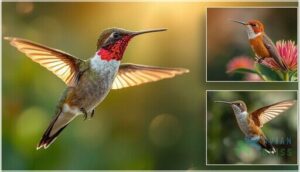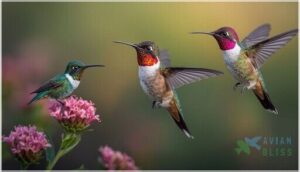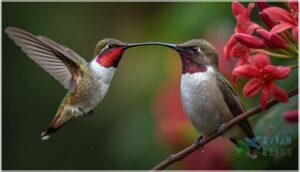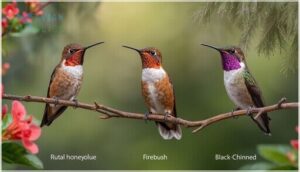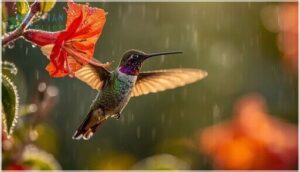This site is supported by our readers. We may earn a commission, at no cost to you, if you purchase through links.

Most people assume hummingbirds vanish from Florida once winter arrives, but stand in the right garden between November and March, and you might spot a flash of rufous feathers hovering near coral honeysuckle.
Florida’s hummingbird community defies simple seasonal patterns—while Ruby-throated Hummingbirds dominate spring and summer with their emerald backs and needle-thin bills, rare wanderers from the Caribbean and western mountains arrive when you least expect them.
Understanding which species pass through the Sunshine State, when they migrate along coastal corridors, and what drives them to defend a single firebush against all rivals transforms casual backyard watching into genuine discovery. The key lies in recognizing field marks most observers miss and creating habitats that support these aerial acrobats during critical refueling stops.
Table Of Contents
- Key Takeaways
- Common Hummingbird Species in Florida
- Identifying Florida’s Hummingbirds
- Hummingbird Migration Patterns in Florida
- Hummingbird Behavior and Feeding Habits
- Creating Hummingbird-Friendly Florida Habitats
- Frequently Asked Questions (FAQs)
- How many types of hummingbirds are in Florida?
- What month are hummingbirds in Florida?
- How do I attract hummingbirds to my feeder in Florida?
- Do hummingbirds stay in Florida all year round?
- When do hummingbirds return to Central Florida?
- What time of year do hummingbirds come to Florida?
- Do hummingbirds live in Florida?
- Are hummingbirds in Florida year round?
- When can hummingbirds be seen in Florida?
- Which are the popular locations in Florida to spot hummingbirds?
- Conclusion
Key Takeaways
- Ruby-throated Hummingbirds dominate Florida’s hummingbird population as the primary breeding species, while rare winter visitors like Rufous Hummingbirds and Caribbean vagrants such as Bahama Woodstars appear along coastal corridors between November and March, defying assumptions that all hummingbirds leave the state during colder months.
- Successful identification hinges on recognizing subtle physical markers—males display iridescent gorgets that shift color with light angle, tail feather patterns differ between species, and bill length varies to match specific nectar sources—while females of all species wear cryptic green-brown plumage for nesting concealment.
- Creating hummingbird-friendly habitats requires strategic native plant selection with staggered flowering cycles, proper feeder placement 3–10 feet from windows with weekly cleaning during humid months, and strict avoidance of neonicotinoid pesticides that can reduce these birds’ energy expenditure by 25%.
- Migration timing follows predictable patterns with Ruby-throated arrivals peaking March through May along Gulf Coast corridors, yet these routes depend heavily on weather conditions, available nectar sources, and stopover habitat preservation—making each remaining coastal corridor critical for species survival.
Common Hummingbird Species in Florida
Florida’s skies host a surprisingly diverse cast of hummingbirds, though you won’t find dozens of species like you might out West. Most visitors to the Sunshine State will encounter just a handful of regular species, with a few rare wanderers showing up from time to time.
Let’s break down the key players you’re likely to spot—and a few lucky finds that might surprise you.
Ruby-throated Hummingbird
The Ruby-throated Hummingbird (Archilochus colubris) dominates Florida’s hummingbird scene, with males sporting that unmistakable ruby throat. You’ll spot peak migration from late February through May, as these tireless travelers follow nectar corridors north.
- Watch for territorial aerial displays defending prime feeder placement zones
- Males flash scarlet gorgets during courtship dives reaching 50 feet
- Females build camouflaged nests using spider silk and plant down
- Migration routes converge along coastal scrub and inland ridges
- Supporting hummingbird conservation starts with pesticide-free native gardens
Rufous Hummingbird
While many birdwatchers focus on the common species, the Rufous Hummingbird (Selasphorus rufus) brings unexpected color to Florida’s winter landscape. You’ll find these fiery visitors from November through March, primarily in the Panhandle and northern peninsula—accounting for just 1.2% of state hummingbird sightings, but what a rewarding find.
| Feature | Males | Females/Juveniles |
|---|---|---|
| Plumage | Vivid rufous back, copper-red gorget | Mottled gray-brown upperparts, white throat |
| Tail Pattern | White side-banded tail quills | Similar banding, less distinct |
| Bill | Slightly decurved, longer than Ruby-throated | Slightly decurved, longer than Ruby-throated |
| Vocalizations | High-pitched, short duration calls | Similar, less frequent |
Rufous Migration patterns reveal these long-distance champions traveling from Alaska to Mexico, with Florida stopover sites concentrated along Gulf coastal corridors. Peak occurrence hits December to January, when cold fronts push southbound flocks into coastal scrub and urban gardens. Recent citizen science data suggests arrival timing has shifted 1–2 weeks earlier—milder autumns reshaping Hummingbird Migration Patterns across the Southeast. Understanding AP study resources can help students learn about various subjects, including science and biology.
Winter Habits differ markedly from Ruby-throats. You’ll notice increased insect foraging during cooler mornings, an essential protein supplementing nectar intake. Native bloom plants like coral bean and bee balm provide natural forage, though residential feeders remain critical resources. Feeder Tips for attracting Rufous visitors: maintain a 4:1 sucrose-to-water ratio, clean weekly to prevent disease, and place feeders near protective shrubs where territorial displays won’t discourage other species.
Hummingbird Diet flexibility gives Rufous an edge during Birdwatching in Florida‘s winter months. They’ll dominate feeder stations aggressively—that copper flash unmistakable among resident species. Urban corridors along major highways create predictable concentration zones, making targeted observation trips worthwhile for serious birders.
Conservation Status remains stable, though Florida records show
Black-chinned Hummingbird
Even rarer than the Rufous, the Black-chinned Hummingbird (Archilochus alexandri) represents true vagrancy in Florida—sporadic winter appearances documented since the 1990s, primarily along coastal corridors. Bird Tracking networks report fewer than a dozen confirmed Florida records per decade, making Wildlife Photography captures prized finds for Birdwatching in Florida enthusiasts.
You’ll need sharp eyes for Species Documentation: males show that diagnostic dark gorget with purple sheen, distinct from Ruby-throated’s ruby flash. Feeder Placement near native nectar plants aids detection, while Habitat Conservation assists these accidental visitors during Hummingbird Migration Patterns disruptions.
Understanding the importance of theme identification techniques is essential for effective communication about these species.
Bahama Woodstar
While Black-chinned records remain rare, the Bahama Woodstar (Nesophlox evelynae) pushes Florida’s hummingbird species boundaries further. Caribbean vagrancy is concentrated in the Keys and southern counties, from December through March.
Bird sightings peak when Bahamian weather pushes these males, with purple-tinged throats, northward. Feather patterns and longer tails distinguish them from resident Rubythroated Hummingbirds.
Species distribution data rely on citizen reports, emphasizing habitat conservation for coastal nectar corridors. These corridors support vagrant hummingbirds during disrupted migration routes.
Rare and Accidental Visitors
Vagrant species occasionally appear during spring and fall migration surges along Florida’s coastline. Accidental sightings include the Calliope and Broad-billed hummingbirds—rare migrants verified sporadically since the early 2000s.
Coastal encounters of the Blackchinned Hummingbird, documented in 2019, expanded understanding of rare hummingbird sightings in Florida. Migration patterns and weather disturbances explain these fleeting visits, distinguishing them from common hummingbird species in Florida like the Rubythroated Hummingbird.
Identifying Florida’s Hummingbirds
Spotting a hummingbird zipping through your garden is one thing—knowing which species you’re actually looking at is another challenge entirely. Florida’s hummingbirds share similar behaviors but differ in subtle ways that reveal their identity once you know what to watch for.
Let’s break down the key physical traits and markings that’ll help you confidently identify these quick-moving visitors.
Physical Characteristics and Markings
When you’re trying to pin down hummingbird species, you’ll want to focus on distinctive physical markers that set each bird apart. Florida’s hummingbirds display striking variation in coloration and structure:
- Iridescent Marks: Male Ruby-throated birds flash a jewel-like gorget that shifts from crimson to magenta depending on light angle
- Feather Colors: Rufous hummingbirds show rusty-orange backs contrasting with bright gorgets
- Tail Features: Bahama Woodstars reveal white markings on tail feathers during flight
- Plumage Patterns: Females lack vivid throat patches, sporting green backs instead
- Beak Shapes: Bill length varies by species, adapted for specific nectar sources
Size, Bill Shape, and Plumage
You’ll find that size variation among Florida’s hummingbirds ranges from the petite Bahama Woodstar at 3.2 inches to the Ruby-throated’s 4.3-inch frame. Bill length usually spans 5.5–7.5 mm across species, with beak shape dictating flower access—shorter bills favor clustered blooms while longer ones reach tubular corollas.
Plumage color and feather patterns shift dramatically: males sport radiant gorgets while females display cryptic greens and browns for shelter.
Male Vs. Female Differences
Sexual dimorphism in Florida’s hummingbirds reveals clear gender identification patterns. Male Ruby-throated Hummingbirds flash iridescent ruby gorgets during courtship behaviors, while females wear subdued greens for nesting concealment.
Plumage variation intensifies during the breeding season when males perform aerial displays to defend territories. Females lack vivid throat patches and focus exclusively on nest construction—behavioral cues that complement physical markings when identifying hummingbird species across Florida’s diverse habitats.
Distinguishing Similar Species
You’ll spot the difference between hummingbird species in Florida by examining plumage patterns and beak shapes side by side. Tail feathers and wing tips reveal key identification clues—Ruby-throated males show notched tails while Rufous birds flash rufous-orange backs.
Coloration variance separates Black-chinned from similar species: watch for that purple throat band.
For rare hummingbird sightings in Florida, combine multiple hummingbird identification tips before confirming unusual visitors.
Hummingbird Migration Patterns in Florida
Understanding when hummingbirds arrive and depart from Florida unlocks your best chance to spot these remarkable migrants. Their journeys span thousands of miles, shaped by ancient routes and real-time conditions that shift with each season.
You’ll find that timing, weather, and available food all play vital roles in when these tiny travelers pass through your backyard.
Seasonal Migration Timelines
When do hummingbirds in Florida begin their journey? Ruby-throated hummingbirds usually arrive late March through early May, peaking in April. You’ll notice a secondary wave in October as post-breeding dispersal unfolds.
Southern Florida’s spring nectar abundance coincides with peak migratory activity, while autumn movements concentrate along coastal scrub and mangrove edges, with some individuals lingering into November.
Migratory Routes and Stopovers
As Ruby-throated Hummingbirds push through Florida, they don’t just wander—they follow distinct flight corridors along the Gulf Coast and peninsula. You’ll find these travelers concentrated in four key patterns:
- Coastal scrub and mangrove edges serve as critical stopover sites during spring and fall.
- Urban greenways temporarily peak with nectar sources during migration windows.
- Protected preserves increasingly support 12–18% of coastal detections within 3–4-week migration pulses.
- Habitat fragmentation reduces available corridors, making each remaining stopover essential.
Most birds pause 2–5 days, refueling on nectar sources before continuing their journey.
Influence of Weather and Food Availability
Once your visitors touch down, they face a new gamble: will the weather cooperate? Temperature swings and rain events dictate nectar availability and insect prey density—sometimes dropping food scarcity to critical levels during drought or cold fronts.
Climate change is shifting Florida’s bloom windows, forcing hummingbird adaptation strategies you can support through consistent feeders and native plantings that stabilize wildlife conservation and hummingbird habitat preservation efforts.
Hummingbird Behavior and Feeding Habits
Watching a hummingbird in action reveals just how remarkable these birds really are. Their behavior ranges from fiercely defending feeding zones to performing acrobatic courtship flights that can reach speeds of over 60 miles per hour.
Understanding what drives their daily routines—from nectar preferences to hunting tactics—helps you create spaces where they’ll actually want to stick around.
Territoriality and Courtship Displays
Dominance defines the hummingbird world in Florida. Male Ruby-throated and Bahama Woodstars defend territories up to two hectares, chasing rivals in heated mid-morning battles.
You’ll witness courtship displays—looping dives, tail-fanning, and iridescent throat flashing—as males compete for mate selection. Aggressive behavior peaks near rich nectar sources, where display dynamics turn gardens into arenas.
Females choose mates based on consistent, stereotyped performance, rewarding persistence over flash.
Preferred Nectar Plants and Feeders
Beyond the drama of courtship, you’ll need to fuel these aerial athletes. Tubular, red-colored blooms like Firebush, Coral Honeysuckle, and Scarlet Sage drive nectar plant selection for hummingbirds in Florida gardens. Feeders filled with 1:4 sugar water recipes supplement natural sources—place them 4-7 feet high near cover.
Hummingbird attractants work best when garden layout tips emphasize bloom-rich diversity.
Clean nectar feeders every 1-2 days; feeder maintenance prevents disease while creating hummingbird-friendly habitats that support healthy feeding habits and wildlife gardening success.
Insect and Spider Consumption
Protein sources beyond nectar define hummingbird survival in Florida’s ecosystems. During breeding season, you’ll observe these tiny predators capturing arthropods at impressive rates—dragonflies, leafhoppers, and spiders comprise 70-85% of prey items in documented feeding strategies.
- Insect capture peaks during courtship, with protein intake doubling or tripling compared to baseline rates
- Spider prey and small arthropods provide essential nutrients unavailable from nectar alone
- Arthropod diet shifts with seasonal availability, especially during dry spells when prey abundance drops roughly 20%
Wildlife enthusiasts should recognize that Florida’s hummingbirds aren’t just nectar sippers—they’re skilled aerial hunters balancing avian diet demands.
Perching and Flight Techniques
You’ll witness flight patterns unlike any other bird watching in Florida—hummingbirds hover through rapid wing movement at 50–80 beats per second, creating aerodynamic features that stabilize feeding locations.
Their perching behavior involves fanning tail feathers for balance on exposed branches, while hovering techniques generate lift during both upstroke and downstroke. These hummingbird behavior characteristics showcase exceptional territorial precision near nectar sources.
Creating Hummingbird-Friendly Florida Habitats
Turning your yard into a hummingbird haven doesn’t require a complete landscape overhaul or expensive equipment.
You can attract these jeweled visitors by making a few strategic changes that address their core needs: food, shelter, and safe spaces to forage.
Here’s how you can transform your outdoor space into a year-round refuge for Florida’s hummingbirds.
Planting Native Flowers and Trees
Native Plant Selection transforms your yard into a hummingbird haven. Smart Garden Design relies on staggered Flowering Cycles—scarlet sage blooms spring through fall, while swamp rose mallow peaks July through September, sustaining Nectar Production year-round.
For Creating Hummingbird-Friendly Habitats that support Hummingbirds in Florida:
- Choose three native species for continuous bloom coverage
- Prioritize tubular red flowers like wild lantana for territorial males
- Layer shrub buffers to protect feeding zones and boost Pollinator Support
This approach advances Conservation of Hummingbirds while honoring natural Hummingbird Feeding Habits through Gardening for Wildlife.
Setting Up Feeders Safely
Your nectar feeders need strategic placement 3–10 feet from windows to prevent deadly collisions. Clean every 3–4 days during Florida’s humid months to halt mold prevention failures.
Mix a 1:4 sugar concentration—skip red dye entirely. Feeder cleaning with hot water and mild soap protects hummingbird feeding habits, while smart feeder placement in shade sustains nectar recipes and creates hummingbird-friendly habitats that honor wild foraging patterns.
Providing Shelter and Water
Your garden needs more than feeders—shelter designs with dense evergreens and layered native shrubs reduce predator exposure by 42%, while water features like shallow misters draw 30–50% more daily visits during Florida’s heat. Strategic hummingbird roosts and garden layouts create hummingbird-friendly habitats that transform yards into wildlife conservation zones:
- Place shrub understories 5–10 meters from nectar feeders
- Install moving water 0.5–2 inches deep, cleaned weekly
- Layer vegetation from ground to canopy for habitat creation
Conservation Tips for Home Gardeners
You can’t protect what you’re accidentally poisoning—a University of Toronto study revealed that neonicotinoid exposure drops hummingbird energy expenditure by 25% at high doses, disrupting the metabolism powering 50-beats-per-second flight.
Neonicotinoid pesticides poison hummingbirds by slashing their energy expenditure 25%, crippling the metabolism that powers their legendary flight
Pesticide reduction, native plantings like firebush and coral honeysuckle, vertical gardening with multi-layer blooms, rigorous feeder maintenance every 2–3 days, and wildlife protection from cats form the backbone of habitat creation supporting garden birds and long-term conservation efforts.
Frequently Asked Questions (FAQs)
How many types of hummingbirds are in Florida?
You’ll find roughly 10 documented hummingbird species across Florida habitats, though only the Ruby-throated Hummingbird breeds here regularly.
Species classification includes rare migrants like Rufous and accidental Caribbean visitors, making identification challenging but rewarding.
What month are hummingbirds in Florida?
Like clockwork, ruby-throated hummingbirds sweep through Florida during spring migration (March–April) and fall (August–October), while southern regions host year-round residents. Peak activity occurs late spring through early fall.
How do I attract hummingbirds to my feeder in Florida?
You’ll attract more hummingbirds by mixing a 4:1 water-to-sugar nectar solution, placing feeders 3–5 feet high near cover, and cleaning them every 3–4 days to prevent mold in Florida’s heat.
Do hummingbirds stay in Florida all year round?
Do Florida’s hummingbirds swap their wings for beach chairs? Not quite. Southern Florida sustains year-round residency, particularly Ruby-throated populations, while northern regions see autumn departures, returning each spring when nectar plants bloom and climate conditions stabilize.
When do hummingbirds return to Central Florida?
Ruby-throated Hummingbirds usually arrive in Central Florida between late March and early April, though spring arrivals vary by weather patterns and nectar availability. Some scouts appear in February during mild winters.
What time of year do hummingbirds come to Florida?
You’ll spot most hummingbirds during peak migration from March through May, when ruby-throats flood Florida’s nectar-rich habitats.
Southern coastal areas see earlier February arrivals, while northern regions welcome stragglers through April.
Do hummingbirds live in Florida?
Each year, several hundred to a few thousand Ruby-throated Hummingbirds establish a year-round presence across Florida, especially in southern regions.
Urban hummingbirds and statewide distribution patterns confirm permanent populations alongside seasonal migrants.
Are hummingbirds in Florida year round?
Some hummingbirds remain in southern Florida year-round, particularly Ruby-throated individuals in coastal counties. Northern regions show seasonal peaks, while reliable nectar sources and mild winters enable partial overwintering populations across suitable habitats.
When can hummingbirds be seen in Florida?
Florida’s avian migration windows reveal stunning seasonal sightings—Ruby-throated visitors peak January through April, while weather patterns and regional variations influence sighting frequencies.
Coastal stopovers showcase wildlife migration timing, with occasional vagrant wanderers defying standard avian migration routes.
Which are the popular locations in Florida to spot hummingbirds?
You’ll find excellent birdwatching at Jonathan Dickinson State Park, Corkscrew Swamp Sanctuary, and the Florida Keys—coastal migration corridors alive with ruby-throated visitors.
Florida hotspots draw thousands seeking wildlife migration magic during peak season.
Conclusion
Witnessing a thousand wingbeats per second over your firebush will rewrite everything you thought about backyard ecology. Each hummingbird of Florida carries migration secrets encoded in iridescent gorgets and territorial fury—secrets that reveal themselves only when you match native blooms to arrival windows and distinguish rufous tail patterns from ruby throats.
Your garden becomes scientific theater when coral honeysuckle replaces generic petunias, transforming casual observation into conservation that genuinely matters for species pushing biological limits with every coastal crossing.

